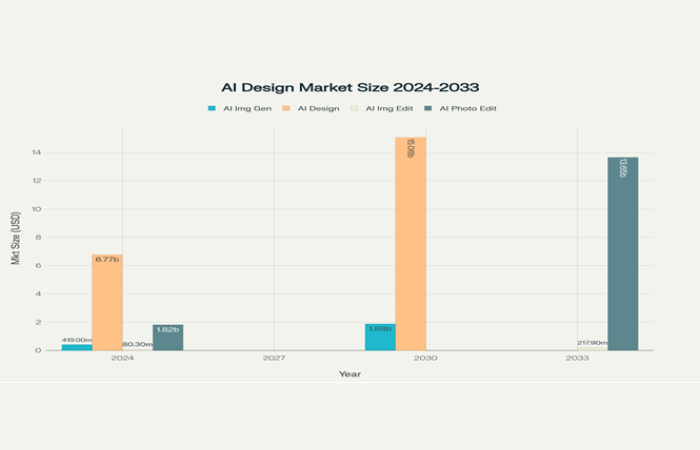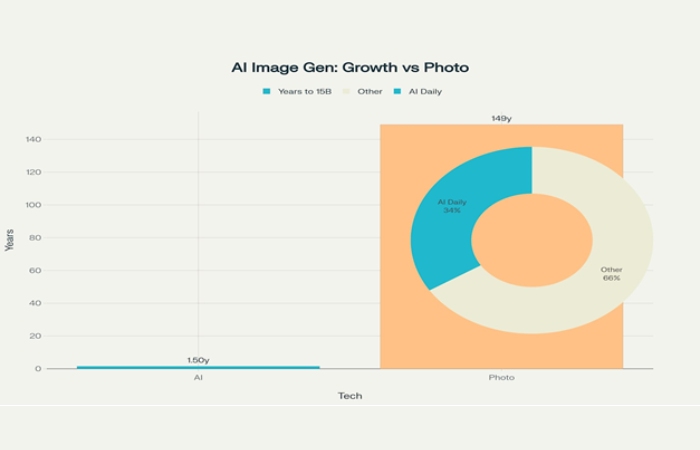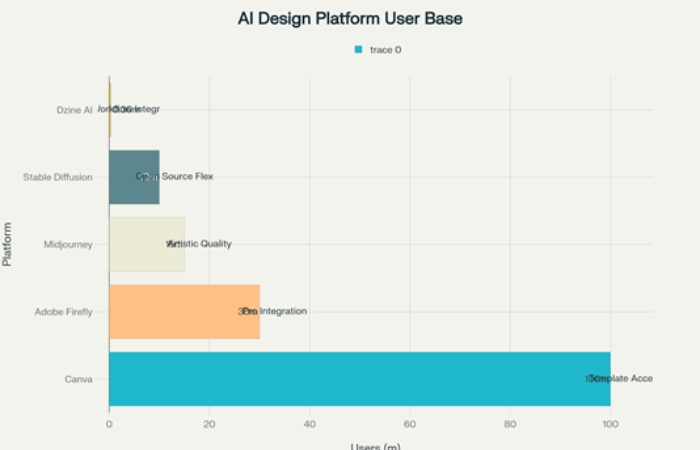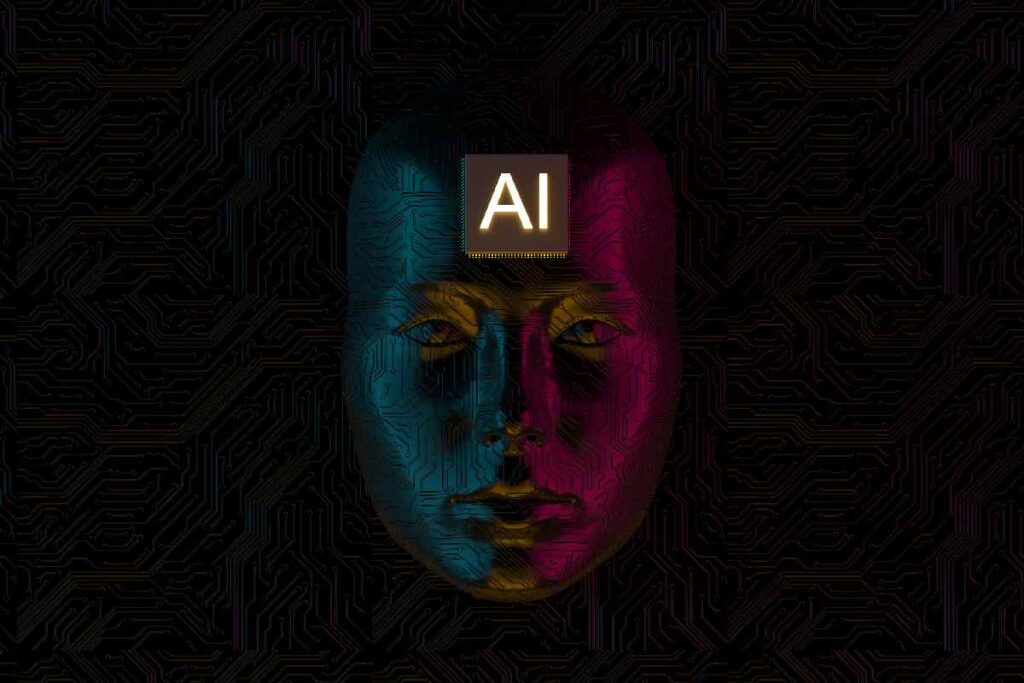The AI design industry has experienced explosive growth since 2022, fundamentally transforming how visual content is created, edited, and optimized. With 34 million AI-generated images created daily1 and over 15.5 billion total images generated since 20221, this technological revolution has achieved in just 1.5 years what traditional photography took 149 years to accomplish.
The market demonstrates robust expansion across multiple segments, with the AI-powered design tools market projected to grow from $6.77 billion in 2024 to $15.06 billion by 2030, representing a 22.1% compound annual growth rate (CAGR)6. Meanwhile, the broader AI image generator market is expected to reach $60.8 billion by 2030, showcasing the immense commercial potential of this technology.

Table of Contents
AI Design Market Landscape: Current vs. Projected Market Sizes (2024-2033)
Market Size and Growth Projections
Current Market Landscape
The AI design market encompasses several interconnected segments, each experiencing significant growth:
- AI Image Generator Market: Valued at $419.2 million in 2024, this segment is projected to reach $1.88 billion by 2030, representing an 18.1% CAGR. This growth is driven by increasing demand for automated visual content creation across marketing, entertainment, and e-commerce sectors.
- AI-Powered Design Tools Market: The largest segment at $6.77 billion in 2024, expected to reach $15.06 billion by 2029 with a 22.1% CAGR. This market benefits from widespread adoption of automation in design workflows and growing emphasis on user experience (UX) and user interface (UI) design.
- AI Image Editor Market: Currently valued at $80.3 million in 2024, projected to grow to $217.9 million by 2034 with a 10.5% CAGR. This segment focuses on enhancing existing images through AI-powered editing capabilities.
- AI-Generated Photo Editing Market: Valued at $1.82 billion in 2024, this rapidly expanding segment is projected to reach $13.65 billion by 2033 with an impressive 22.3% CAGR.
Regional Distribution and Market Dynamics
North America leads the global market with 36.1% of revenue share in 2024, driven by technological advancement and home to major AI image generator vendors. The Asia Pacific region is experiencing rapid expansion with a 26.10% CAGR, while the Middle East shows 24.38% CAGR growth.
The software segment dominates market share in 2024, with image generation applications expected to propel market growth. The media and entertainment sector captures the largest revenue portion, while e-commerce and retail segments show exceptional growth at 28.97% CAGR.
Daily Production Volume and Industry Impact
The scale of AI image generation is unprecedented in creative industries. Approximately 34 million new AI-generated images are created daily, resulting in an annual production of over 12.4 billion images. This massive volume represents a paradigm shift in visual content creation, with profound implications for businesses, creators, and consumers.

AI Image Generation Revolution: Volume and Speed Statistics
Platform Distribution and Technology Adoption
Research indicates that approximately 80% of AI-generated images utilize models based on Stable Diffusion, highlighting the dominance of open-source AI technologies. The breakdown of image generation by platform includes:
- Stable Diffusion: 12.59 billion images (80% of total)
- Adobe Firefly: 1 billion images in just three months since launch
- Midjourney: 964 million images since launch
- DALL-E 2: 916 million images in 15 months
Competitive Landscape Analysis
The AI design tools market features a diverse ecosystem of platforms, each targeting specific user segments and use cases. The competitive landscape reveals significant disparities in user adoption and market positioning.

AI Design Platform Competitive Landscape: User Base and Key Strengths
Major Market Players
- Canva leads in user adoption with over 100 million users, positioning itself as the accessibility leader through its template-driven approach and intuitive drag-and-drop functionality. The platform’s strength lies in democratizing design for non-designers and small marketing teams.
- Adobe Firefly leverages 30 million Adobe Creative Cloud users and benefits from deep integration within the professional Creative Cloud ecosystem. Adobe’s AI strategy focuses on enhancing existing professional workflows rather than replacing them.
- Midjourney has established a strong position with 15 million users and a reputation for producing high-quality, artistic images. The platform’s Discord-based interface creates a unique community-driven experience that appeals to creative professionals and enthusiasts.
- Stable Diffusion commands over 10 million users across all channels and represents the open-source alternative, enabling widespread customization and integration across various platforms and applications.
- Dzine AI positions itself as an emerging all-in-one platform with 300,000 users, focusing on integrated workflows that combine generation and editing capabilities within a single interface.
Competitive Differentiation
The market demonstrates clear segmentation based on user needs and technical approaches:
- Artistic Excellence vs. Practical Utility: Midjourney excels in creating aesthetically unique art, while platforms like Dzine AI focus on practical, all-in-one solutions for immediate workflow integration.
- Template-Driven vs. Generative Approaches: Canva’s template-rich environment contrasts with AI-native platforms that emphasize generating unique visuals from scratch.
- Professional Integration vs. Accessibility: Adobe Firefly leverages professional tool integration, while emerging platforms prioritize user-friendly interfaces that don’t require extensive training.
Technology Trends and Innovation Drivers
Advanced AI Model Development
The industry is experiencing rapid advancement in diffusion models and Generative Adversarial Networks (GANs). These technological improvements enable more realistic image generation, better prompt adherence, and enhanced creative control.
Multimodal AI capabilities are expanding, allowing platforms to process text, images, and audio inputs simultaneously. This convergence enables more sophisticated creative workflows and personalized content generation.
Integration and Workflow Enhancement
Cloud-based solutions are driving adoption by offering scalability and real-time collaboration capabilities. The integration of AI tools into existing design platforms, such as Figma AI and Adobe Sensei, streamlines creative processes and reduces workflow friction.
Layer-based editing systems are emerging as a key differentiator, allowing users to maintain precise control over AI-generated content while benefiting from automated capabilities.
Emerging Applications
Hyper-personalization is becoming a critical trend, with AI enabling customized visual content at scale. Text-to-video generation and 3D modeling capabilities are expanding the scope of AI-assisted creativity beyond static images.
Real-time collaboration features and API integrations are enabling businesses to incorporate AI generation capabilities directly into their existing workflows and applications.
Industry Challenges and Considerations
Ethical and Legal Concerns
The rapid growth of AI-generated content has intensified debates around copyright and intellectual property rights. Current U.S. copyright law states that works created solely by AI cannot be copyrighted, creating uncertainty for businesses and creators.
Bias and discrimination in AI algorithms remain significant concerns, as these systems can perpetuate societal biases present in training data. The industry is increasingly focused on developing ethical AI frameworks and ensuring diverse, representative datasets.
Market Saturation and Quality Concerns
The democratization of design tools has led to market saturation and concerns about commoditization of creative work. As AI tools become more accessible, there’s growing emphasis on maintaining originality and avoiding homogeneous design outputs.
Quality consistency remains a challenge, with users reporting occasional glitches and uneven results from AI-generated content. The industry is addressing these concerns through improved model training and human oversight mechanisms.
Technical and Infrastructure Challenges
Data quality and availability pose significant barriers to AI adoption. Organizations must address issues of data privacy, security, and bias while ensuring access to high-quality training datasets.
Computational requirements for AI image generation remain substantial, with environmental concerns about energy consumption gaining attention. The industry is exploring more efficient algorithms and sustainable computing practices.
Industry Applications and Use Cases
Marketing and Advertising
The advertising sector holds the largest market share in AI image generation, leveraging AI for rapid campaign creation, A/B testing of visual concepts, and personalized marketing materials. Companies report significant time savings and cost reductions in content production workflows.
E-commerce and Retail
E-commerce applications are experiencing 28.97% CAGR growth, with businesses using AI for product photography, virtual try-on experiences, and personalized visual content. AI-generated product images enable rapid catalog expansion without traditional photography costs.
Media and Entertainment
The media and entertainment sector captures the largest revenue portion, utilizing AI for concept art, visual effects, character design, and promotional materials. These applications streamline production workflows and enable creative experimentation at unprecedented scales.
Social Media and Content Creation
Individual creators and social media managers leverage AI tools for content creation, with platforms enabling rapid generation of posts, stories, and marketing materials tailored to specific audiences and brand guidelines.
Future Outlook and Recommendations
Market Trajectory
The AI design landscape is positioned for continued expansion, with conservative projections indicating 15-25% annual growth across major market segments through 2030. The convergence of improved AI capabilities, reduced computational costs, and increased market awareness will drive mainstream adoption.
Strategic Considerations for Businesses
- Integration Strategy: Organizations should evaluate AI design tools based on workflow compatibility rather than feature sets alone. The most successful implementations integrate AI capabilities into existing creative processes rather than replacing them entirely.
- Skill Development: The industry trend suggests AI will augment rather than replace human creativity. Professionals should focus on developing strategic thinking, creative direction, and AI tool proficiency to remain competitive.
- Quality Assurance: As AI-generated content becomes more prevalent, businesses must establish quality control processes and brand consistency guidelines to maintain competitive differentiation.
Technology Evolution
Real-time generation capabilities will continue improving, with expectations for instant image creation and live editing functionality. 3D and video generation will expand significantly, creating new market opportunities and applications.
Collaborative AI features will enable team-based creative workflows, while API-first approaches will facilitate custom integrations and enterprise-scale deployments.
Conclusion
AI design is rapidly transforming from a niche technology to a mainstream creative force, with the industry projected to surpass $60 billion by 2030. Leading platforms like Canva and Adobe are leveraging their established user bases, while new entrants such as Dzine AI are innovating with integrated workflows. Despite ongoing challenges around copyright, bias, and quality, AI-assisted design tools offer significant benefits—faster creation, expanded creative possibilities, and broader access to professional-quality design. For businesses and creators, the strategic adoption of AI design tools, combined with a focus on human creativity and quality control, will be key to staying competitive in a fast-growing market. The future of visual content creation will be shaped by organizations that balance technological innovation with ethical considerations and creative authenticity.

